NMR Operations for QE 300 with Tecmag Data System
Prepared by M.D. Timken and M.R. Schultz 1/94. Revised S.E. Van Bramer 7/95. HTML Markup 7/96. Revised for Tecmag 1/02 and 8/02
Magnetic Materials and Safety Considerations
- If you have a pacemaker or other metallic implant, do not enter Room 421. The large magnetic field associated with a 300MHz superconducting magnet can interfere with the operation of a pacemaker, or could possibly result in tissue tears at the site of a metallic (magnetic) implant.
- Do not put any magnetic (mainly iron) items near the magnet. The magnet will strongly attract such items. For example, a moderately heavy item like a wrench or even a screwdriver could puncture the stainless steel vacuum dewar if it were dropped near the magnet. Keep such items on the "door-side" of the yellow warning rope.
- A massive magnetic item like a gas cylinder could move the superconducting coil, even if the cylinder did not come in contact with the dewar. Do not bring such a cylinder into Room 421 unless you have permission from Marty Schultz or Professor Van Bramer.
- And even small items like paper clips or staples can eventually find their way up into the magnet and thus interfere with the collection of spectra. So try not to drop such items in the room, and certainly do not take them past the yellow warning rope.
- The magnetic field is strong enough to erase information from magnetic storage media. Such media (found on credit cards, ATM cards, computer diskettes, and audio tapes) should be removed from your person before you cross the yellow warning rope. It would be wise to remove your wallet and analog watch before crossing the yellow warning rope.
- Do not work unsupervised. You should always arrange your work on the NMR with either Professor Van Bramer or Marty Schultz.
- Follow directions. The NMR is an expensive piece of equipment (worth about $150,000) and can be damaged if used improperly.
Sample Preparation
- Samples should be run as solutions in one of the deuterated solvents found in the cabinet in Room 421. (NOTE: The use of a deuterated solvent is necessary because the spectrometer uses the deuterium NMR signal to lock the magnetic field.) In preparing your samples, it is best to use one of the high-quality 8" NMR tubes, although the 7" tubes can provide adequate spectra for routine samples.
- For liquid samples, use a clean disposable pipette to add carefully one or two drops of sample to a clean, dry NMR tube. Then use the sample gauge to add deuterated solvent to a height of 4 cm from the bottom of the tube. (The black mark on the short side of the gauge.) Cap the tube and mix the sample well.
- For solid samples, use a microspatula to add carefully one or two spatula tips of sample to a clean dry NMR tube. Again, fill with solvent to 4 cm, cap, and mix well.
- Of course, problems such as air instability, water instability, or low solubility will require different approaches for preparing good samples.
- Always wipe the outside of your tube with a clean Kimwipe before placing it into the spectrometer. Only handle the tube by the cap and never touch the spinner with your fingers. This step will keep the spectrometer probe clean and free from contaminants and skin oils.
Setting up the QE300+ NMR Spectrometer
- Sign-in the Logbook. Record all requested information.
- The QE300+ uses a Tecmag data acquisistion system to run the instrument and process data. This software is controlled by the Mac computer on the instrument console. The QE300+ spectrometer is always "on". You may, however, need to turn on the computer or load the MacNMR software. A line-shape sample (CHCl3 in deuterated acetone) should always be in the spectrometer if no other sample is being run. The computer should have the QE H1 Setup running. The window below will display on the computer. If it is not running, open the program MacNMR 5.6 and select the QE H1 Setup. The computer has separate directories containing appropriate setup files for different classes. The menu buttons at the top left include:
 Dashboard. This shows the primary instrument settings in use.
Dashboard. This shows the primary instrument settings in use.
 Comments
Comments
 Control Panel. This opens the instrument control windows.
There are three primary control panels for the instrument. You can toggle between them using the following buttons.
Control Panel. This opens the instrument control windows.
There are three primary control panels for the instrument. You can toggle between them using the following buttons.
 Lock - Controls deuterium solvent lock The lock control panel, shown below, is used to:
Lock - Controls deuterium solvent lock The lock control panel, shown below, is used to:
- Set the lock solvent
- Set the lock transmitter power
- Set the lock transmitter offset
- Turn the lock on
- Turn the lock to standby
- Run the autolock
 Shim - Controls the shim settings. The shim control panel, shown below, is used to:
Shim - Controls the shim settings. The shim control panel, shown below, is used to:
- Load shim settings
- Save shim settings
- Optimize the shims (typically spinning Z1, Z2, and Z3)
- Control the spinner
 Frequency - Controls the acquistion frequency, decoupling, sample loading, spinning.The frequency control panel, shown below, is used to:
Frequency - Controls the acquistion frequency, decoupling, sample loading, spinning.The frequency control panel, shown below, is used to:
- Eject the sample
- Load the sample
- Set the proton decoupler
- Reciever settings
- Observation frequency (don't adjust here)
 Pulse Program. This opens the pulse programing window.
Pulse Program. This opens the pulse programing window.
- Load Your Sample into the Spectrometer.
- Remove the plastic cap from the top of the magnet stack.
- Eject the current sample from the spectrometer. Click on the
 button in the QE H1 Setup window to open the instrument control console.
button in the QE H1 Setup window to open the instrument control console.
- Switch to the lock control, by pressing the lock button
 and switch the lock to standby.
and switch the lock to standby.
- Switch to the frequency console using the frequency button
 on the control panel.
on the control panel.
- Eject the sample by presssing the eject button.
- Get a Kimwipe to carefully remove the sample and spinner from the stack.
- Carefully remove the spinner by sliding it off of the NMR tube. (Do not to touch the spinner with your fingers, use a Kimwipe.)
- Place the spinner on your sample tube, and adjust the spinner height with the gauge. (Using the tall side.)
- Wipe the sample region again with a Kimwipe, and carefully replace it in the stack.
- Lower the sample into the spectrometer probe by pressing the load button.
- Replace the plastic cap on the magnet stack.
- Setup the solvent lock.
- Enter the shim mode by pressing the shim control button
 and load the shims for your solvent. Whenever a new sample is placed in the spectrometer, it is necessary to optimize the homogeneity of the magnetic field. This is called "shimming" the magnet. Shimming results in narrower and more symmetric NMR signals and better resolution. The QE300+ uses a program that automatically shims the magnetic field by maximizing the deuterium lock signal.
and load the shims for your solvent. Whenever a new sample is placed in the spectrometer, it is necessary to optimize the homogeneity of the magnetic field. This is called "shimming" the magnet. Shimming results in narrower and more symmetric NMR signals and better resolution. The QE300+ uses a program that automatically shims the magnetic field by maximizing the deuterium lock signal.
- Switch to the lock control, by pressing the lock button
 . The control panel is shown above.
. The control panel is shown above.
- Select the solvent from the pull down menu.
- Set the transmitter power (lock TR) and the zero offset (ZO offset) for the solvent using the table below.
| Solvent | TR | ZO |
| Acetone | 120 | 130 |
| CDCl3 | 220 | 80 |
| C6D6 | 160 | 90 |
| DMSO | 150 | 90 |
| Methanol | 140 | 110 |
| D2O | 150 | 75 |
- Check the lock signal by pressing the sweep button.
- Lock the Spectrometer to the Deuterium Solvent NMR Signal and then run the autolock to optimize the lock settings.
- Enter the shim mode by pressing the shim control button
 .
.
- Select the Course Z1 and Z2 Shims and set the step size to 5. Run the autoshim.
- Select the Z1 and Z2 spinning shims and set the step size to 100. Run the autoshim.
- Close the console.
Collecting Proton Spectra.
- Open the pulse programming window by pressing the pulse button
 and check the pulse sequence. The pulse program window, shown below, includes the following buttons.
and check the pulse sequence. The pulse program window, shown below, includes the following buttons.
 Dashboard. This shows the primary instrument settings in use.
Dashboard. This shows the primary instrument settings in use.
 Comments for the pulse program.
Comments for the pulse program.
 Toggle Pulse Sequence Display between graphical and text.
Toggle Pulse Sequence Display between graphical and text.
 Pulse Acquisition Settings, detailed below.
Pulse Acquisition Settings, detailed below.
 Return to Setup Window to display FID and spectra.
Return to Setup Window to display FID and spectra.
- Setup the data acquisition parameters.
- Open the dashboard using the
 icon in the QE H1 Setup Window. The Dashboard window is shown below.
icon in the QE H1 Setup Window. The Dashboard window is shown below.
The features that can be adjusted here include:
- Scans 1D - The number of spectra acquired. Should be a multiple of 4 for phase cycling.
- SW - The spectral window
- Points - The number of data points acquired. Software rounds down to the next value of 2n.
- PW02 - The pulse width.
- Last Delay - The recycle delay between acquisitions.
- Set the number of acquisitions. This number should be a multiple of 4 for proper phase cycling. A value of 16 or 32 is usually adequate for H-1 samples.
- Set the acquisition delay (Last Delay). This depends upon the T1 relaxation time constant and the pulse angle of your experiment. 1s is usually sufficent for H-1 samples. For accurate integration increase the acquisition delay, ideally this should be set at 5*T1 for accurate integration.
- Set the Points 1D.
- Set the pulse width.
- Set the Receiver Gain. For each sample, it is necessary to set the receiver gain to insure that the NMR signal coming from the probe is neither too large or too small to be digitized. (NOTE: This step is roughly analogous to adjusting the volume control on a radio - you adjust the volume so that the receiver (your ears) are not overloaded by sound, but so that you can hear the radio.) Again, the easiest way to adjust the receiver gain on the QE300+ is to use an automatic program called a script. Run the auto reciever gain script using the script menu
 from the menu bar.
from the menu bar.

- Collect and Save the H-1 NMR Free-Induction Decay (FID) Signal.
- Run the experiment {Commands, Zero and Go}. The monitor should display the FID; it will take a few minutes to complete the data collection. The Acquisition Status will display the time and scans remaining.
The 1D data acquisition box appears as:

- Save the FID data. Use a *.NMR extension for the file.
Process the H-1 NMR Spectrum
- Correct the baseline of the FID.
- Zero fill the FID.
- Fourier Transform the FID to the NMR spectrum.
- Run an autophase (AP) script using the script menu
 from the menu bar.
from the menu bar.

- Set the TMS peak to 0.0 PPM.
- Zoom in on TMS Peak, Drag region then click on it to expand. Return by clicking on full spectrum shown above.
- Click on peak
- {Display, Set Reference}
- Enter 0
- click OK.
- Integrate the H-1 Spectrum. {Options, Integral, then drag.}
- Print the Spectrum.
NOTE: If you do not need to collect C-13 NMR data, go to the directions for completing your work on the QE 300.
Collect C-13 Spectra.
- Change the spectrometer settings to collect carbon-13 data by closing the QE H1 Setup and reopening Mac NMR 5.6 using the QE C13 Setup.
- Since you have already locked and shimmed the spectrometer for your proton NMR spectrum, it is not necessary to repeat these procedures.
- Carbon-13 pulse sequence and dashboard are shown below
- Set the acquisition delay and number of scans in the dashboard (Last Delay).
- Set the pulse width in the dashboard.
- Set the Receiver Gain. Run the auto reciever gain script using the script menu
 from the menu bar.
from the menu bar.

- Run the experiment {Commands, Zero and Go}. The monitor should display the FID; it will take a few minutes to complete the data collection. The Acquisition Status will display the time and scans remaining.
- Save the FID data. Use a *.NMR extension for the file.
Process the C-13 NMR Spectrum
- Correct the baseline of the FID.
- Zero fill the FID.
- Exponential multiply the FID (Commdand Exponential Multiply). (This multiplication increases the signal-to-noise but also increases the linewidth of the NMR signals. The LB 1D is set in the Dashboard. The EM command only works if the line broadening parameter is nonzero. A LB of 1.0 should work well.)
- Fourier Transform the FID to the NMR spectrum.
- Run an autophase (AP) script using the script menu
 from the menu bar.
from the menu bar.

- Set the TMS peak to 0.0 PPM.
- Zoom in on TMS Peak
- Click on peak
- {Display, Set Reference}
- Enter 0
- click OK.
- Print the Spectrum.
- Carbon-13 NMR spectra do not typically provide useful integrations. So there is no need to integrate your C-13 spectrum. If you would like run a C-13 spectrum for integration, see Dr Van Bramer for details.
2D Data acquisition and processing
Pulse Acquisition Settings
The pulse acquisition settings window, shown below, is used to turn on 2D acquisition and set parameters for 2D experiments.
Pulse Tables
To edit a pulse table hold the "option" key and click on the table. This will open the following window that is used to edit the table. In this window you may open default tables saved for different experiments. Table T1 is reserved for 1d experiments, Table T2 for 2d, etc.
Sequential Processing
For processing 2D data files that are sequential 1D experiments like the T1 Inversion Recovery or Pi pulse experiments, select the commands and then hold down the option key to select "1DFT". The following window will open.
Acquisition
The 2D data acquisition box appears as:
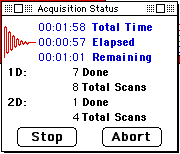
Pi Pulse H-1
Pi Pulse C-13
T1IR H-1
T1IR C-13
Coupled 13C spectrum
- Turn the decoupler off in the control panel
 using the
using the  frequency control panel.
frequency control panel.
DEPT
- Load DEPT Experiment
- Set the number of sweeps and the acquisition delay as appropriate for the sample.
- NOTE: The Decoupler Pulse angle may need to be fine tuned in the
 Pulse Program Setup by changing the values in the T2 table. The current settings are based on 41 Ás for 90░ pulse.
Pulse Program Setup by changing the values in the T2 table. The current settings are based on 41 Ás for 90░ pulse.
- For 45░ DEPT (All carbons +) 20.5 Ás
- For 90░ DEPT (Only CH carbons) 41 Ás
- For 135░ DEPT (CH2 - ; CH and CH3 +) 61.5 Ás
- 1/(2*J), ie: 4.0 ms for 125 Hz
- As appropriate for P2 and T1 relaxation time
- 41 Ás (Proton decoupler 90░ pulse)
- 82 Ás (Proton decoupler 180░ pulse)
COSY
- Load the COSY Experiment.
- Turn the spinner off. Use the
 Control Panel for
Control Panel for  Frequency Control to turn the spinner air off.
Frequency Control to turn the spinner air off.
- Set the spectral window as appropriate for sample
- For 0 to 10 ppm, F 300.149923 MHz, SW +/- 1500 Hz
- For 0 to 5 ppm, F 300.14925 MHz, SW +/- 750 Hz
- Set the number of acquisitions for S/N required
- Set the Recycle delay (Short)
- Open the pulse sequence window and option-click on the pulse table. Enter the value for theFirst Tau and select calculate to generate values for the table.
- Enter a file name
NOESY
- Load the NOESY Experiment.
- Turn the spinner off. Use the
 Control Panel for
Control Panel for  Frequency Control to turn the spinner air off.
Frequency Control to turn the spinner air off.
- Set the spectral window as appropriate for sample
- Set the number of acquisitions for S/N required
- Enter a file name
Hetcor
- Open the Hetcor Setup.
- Turn the spinner off. Use the
 Control Panel for
Control Panel for  Frequency Control to turn the spinner air off.
Frequency Control to turn the spinner air off.
- Set proton window in the
 Pulse Program settings, using the
Pulse Program settings, using the  Pulse Acquisition Settings button.
Pulse Acquisition Settings button.
- Set F2 so that left edge of H-1 window is F2 = (ppm * 300.148502) + 300148502
- Set SW so that SW = 2*ppm*300.15
- Useful settings
| F2 (MHz) | SW (Hz) | Left (ppm) | Right (ppm) |
| 300.151503 | 6000 | 10 | 0 |
| 300.15 | 3000 | 5 | 0 |
| 300.150604 | 5000 | 7 | -1 |
- Then reset the T2 table by entering 1u in box and calculating values.
- Set the number of acquisitions for S/N required
Complete Your Work on the QE300+.
- If you ran C-13 spectra, change the spectrometer to collect proton data.
- Replace your sample with the line-shape sample.
- Reset the solvent to D-6 Acetone.
- Lock the sample as described previously (setting the transmitter Gain to 120 and the offset to 130).
- Shim the magnet.
- Sign out of the log book.
Transfer Files
The computer is setup as a web server, so the data files are available using any web browser. The URL is: http://147.31.140.63
Screen Shots
Proton Setup
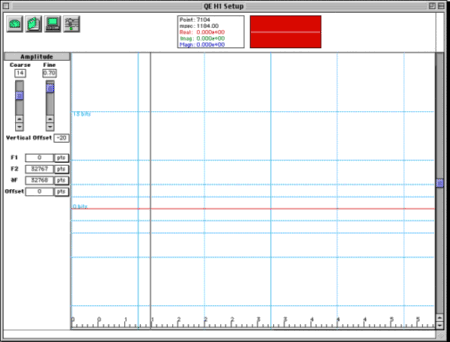
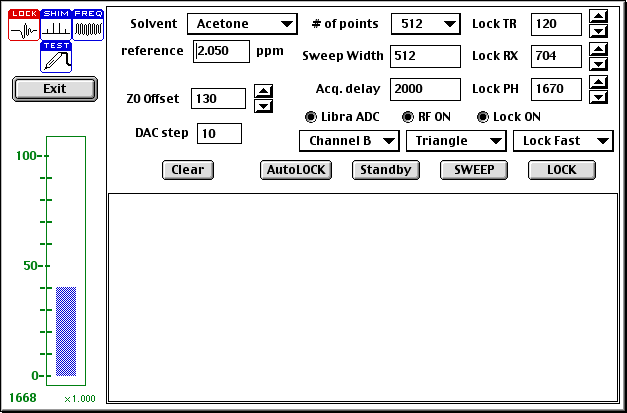
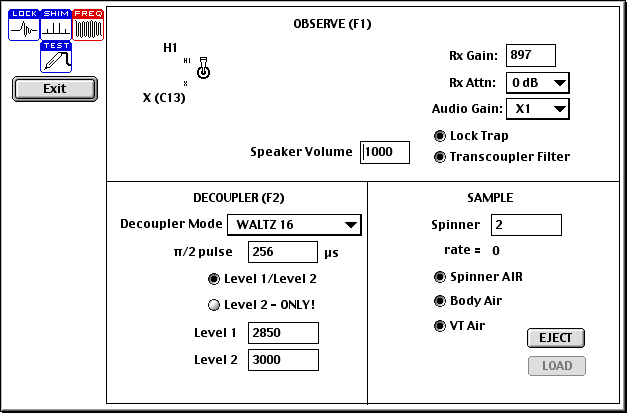
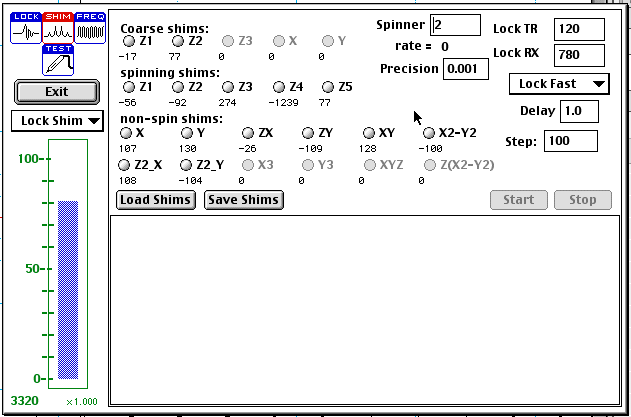


C-13 Setup
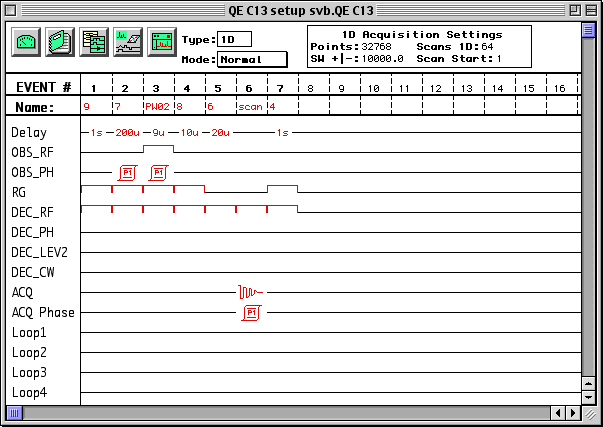
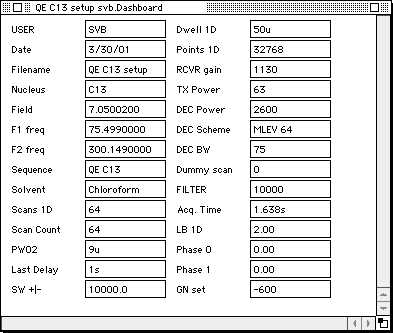
2D Acquisition and Processing Settings

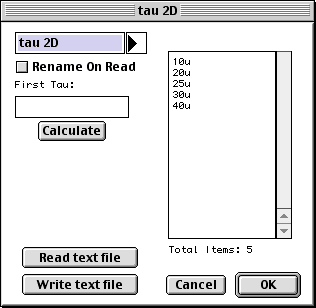

Pi Pulse Experiment
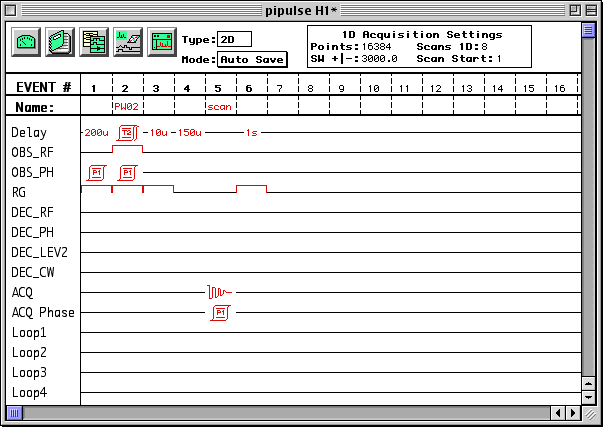

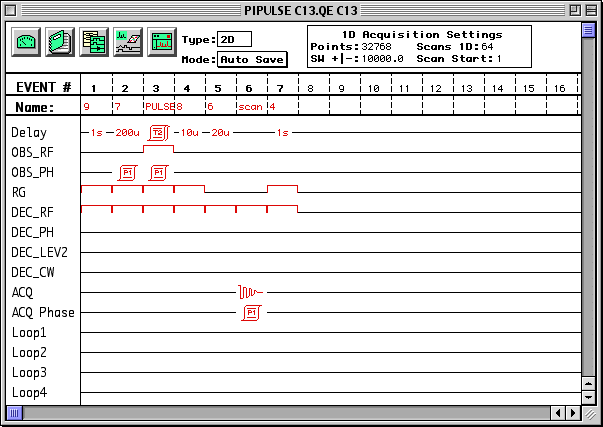
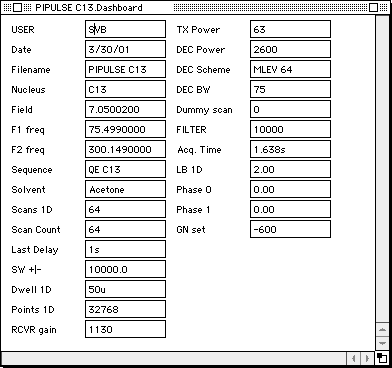
T1IR Experiment
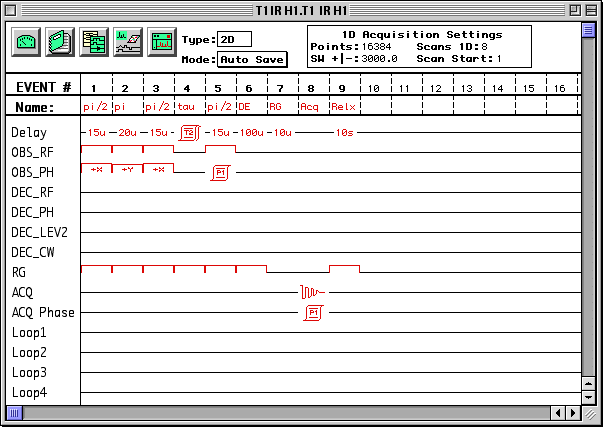
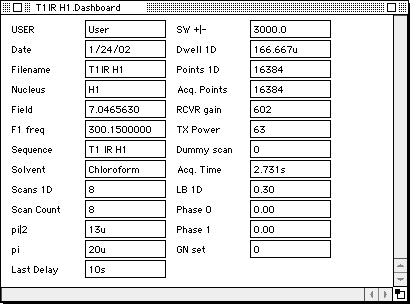
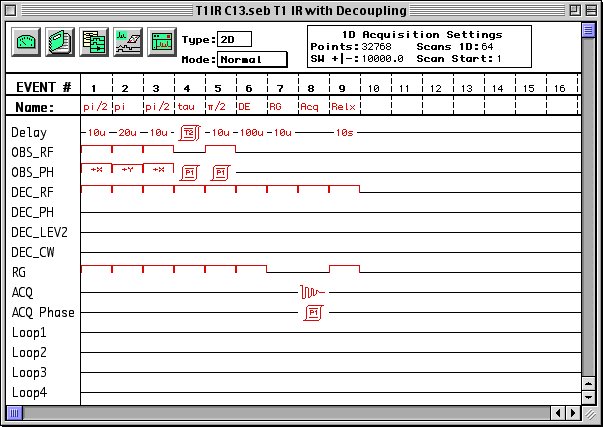
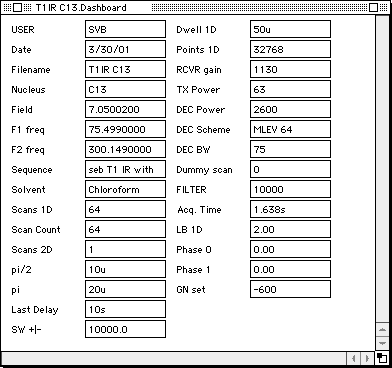
This page is maintained by
Scott Van Bramer
Department of Chemistry
Widener University
Chester, PA 19013
Please send any comments, corrections, or suggestions to
svanbram@science.widener.edu.
This page has been accessed
times since 1/5 /96 .
Last Updated Friday, January 25, 2002 10:04:33 AM
 Dashboard. This shows the primary instrument settings in use.
Dashboard. This shows the primary instrument settings in use.
 Comments
Comments
 Control Panel. This opens the instrument control windows.
There are three primary control panels for the instrument. You can toggle between them using the following buttons.
Control Panel. This opens the instrument control windows.
There are three primary control panels for the instrument. You can toggle between them using the following buttons. Lock - Controls deuterium solvent lock The lock control panel, shown below, is used to:
Lock - Controls deuterium solvent lock The lock control panel, shown below, is used to: Shim - Controls the shim settings. The shim control panel, shown below, is used to:
Shim - Controls the shim settings. The shim control panel, shown below, is used to:
 Frequency - Controls the acquistion frequency, decoupling, sample loading, spinning.The frequency control panel, shown below, is used to:
Frequency - Controls the acquistion frequency, decoupling, sample loading, spinning.The frequency control panel, shown below, is used to: Pulse Program. This opens the pulse programing window.
Pulse Program. This opens the pulse programing window.
 button in the QE H1 Setup window to open the instrument control console.
button in the QE H1 Setup window to open the instrument control console.
 and switch the lock to standby.
and switch the lock to standby.  on the control panel.
on the control panel.
 and load the shims for your solvent. Whenever a new sample is placed in the spectrometer, it is necessary to optimize the homogeneity of the magnetic field. This is called "shimming" the magnet. Shimming results in narrower and more symmetric NMR signals and better resolution. The QE300+ uses a program that automatically shims the magnetic field by maximizing the deuterium lock signal.
and load the shims for your solvent. Whenever a new sample is placed in the spectrometer, it is necessary to optimize the homogeneity of the magnetic field. This is called "shimming" the magnet. Shimming results in narrower and more symmetric NMR signals and better resolution. The QE300+ uses a program that automatically shims the magnetic field by maximizing the deuterium lock signal.  . The control panel is shown above.
. The control panel is shown above.



















